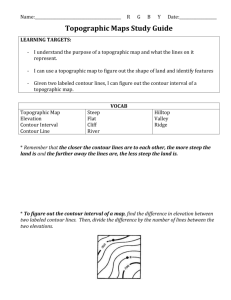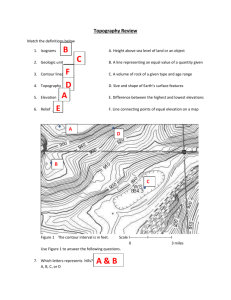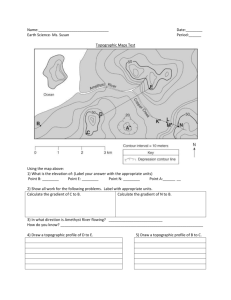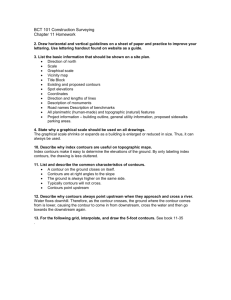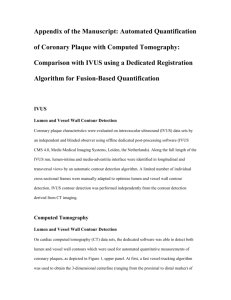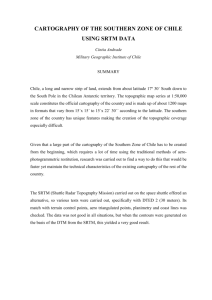Topographic Map Info
advertisement
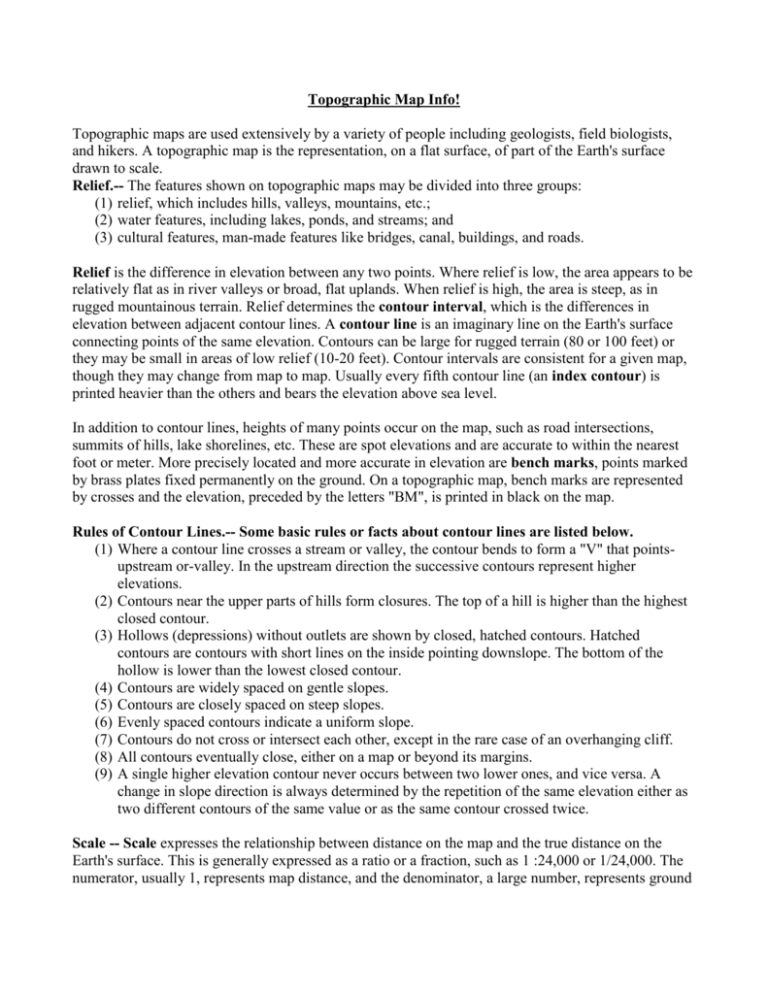
Topographic Map Info! Topographic maps are used extensively by a variety of people including geologists, field biologists, and hikers. A topographic map is the representation, on a flat surface, of part of the Earth's surface drawn to scale. Relief.-- The features shown on topographic maps may be divided into three groups: (1) relief, which includes hills, valleys, mountains, etc.; (2) water features, including lakes, ponds, and streams; and (3) cultural features, man-made features like bridges, canal, buildings, and roads. Relief is the difference in elevation between any two points. Where relief is low, the area appears to be relatively flat as in river valleys or broad, flat uplands. When relief is high, the area is steep, as in rugged mountainous terrain. Relief determines the contour interval, which is the differences in elevation between adjacent contour lines. A contour line is an imaginary line on the Earth's surface connecting points of the same elevation. Contours can be large for rugged terrain (80 or 100 feet) or they may be small in areas of low relief (10-20 feet). Contour intervals are consistent for a given map, though they may change from map to map. Usually every fifth contour line (an index contour) is printed heavier than the others and bears the elevation above sea level. In addition to contour lines, heights of many points occur on the map, such as road intersections, summits of hills, lake shorelines, etc. These are spot elevations and are accurate to within the nearest foot or meter. More precisely located and more accurate in elevation are bench marks, points marked by brass plates fixed permanently on the ground. On a topographic map, bench marks are represented by crosses and the elevation, preceded by the letters "BM", is printed in black on the map. Rules of Contour Lines.-- Some basic rules or facts about contour lines are listed below. (1) Where a contour line crosses a stream or valley, the contour bends to form a "V" that pointsupstream or-valley. In the upstream direction the successive contours represent higher elevations. (2) Contours near the upper parts of hills form closures. The top of a hill is higher than the highest closed contour. (3) Hollows (depressions) without outlets are shown by closed, hatched contours. Hatched contours are contours with short lines on the inside pointing downslope. The bottom of the hollow is lower than the lowest closed contour. (4) Contours are widely spaced on gentle slopes. (5) Contours are closely spaced on steep slopes. (6) Evenly spaced contours indicate a uniform slope. (7) Contours do not cross or intersect each other, except in the rare case of an overhanging cliff. (8) All contours eventually close, either on a map or beyond its margins. (9) A single higher elevation contour never occurs between two lower ones, and vice versa. A change in slope direction is always determined by the repetition of the same elevation either as two different contours of the same value or as the same contour crossed twice. Scale -- Scale expresses the relationship between distance on the map and the true distance on the Earth's surface. This is generally expressed as a ratio or a fraction, such as 1 :24,000 or 1/24,000. The numerator, usually 1, represents map distance, and the denominator, a large number, represents ground distance. Thus, 1 :24,000 means that a distance of 1 unit on the map represents 24,000 such units on the ground. The unit here is not important - it could be meters, feet, or inches. What is important is the relationship between the map distance and the true ground distance. Colors and Symbols-- Each color on a topographic map has significance as follows: Blue = water features; Green = woodlands, orchards, etc.; Red = urban areas, important roads, public-land boundary lines, civil boundaries; Black = man-made works; Brown = contour lines. Purple = new additions





